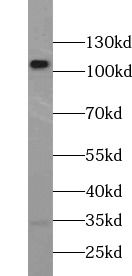Products
UBE3A antibody
Category:
Research Area:
| Synonyms: | ANCR antibody, AS antibody, E6 AP antibody, E6AP antibody, E6AP ubiquitin protein ligase antibody, EPVE6AP antibody, FLJ26981 antibody, HPVE6A antibody, UBE3A antibody, ubiquitin protein ligase E3A antibody | ||
| Catalogue No.: | FNab09189 | Reactivity: | Human, Mouse, Rat |
| Host: | Rabbit | Tested Application: | ELISA, WB, IHC |
| Clonality: | polyclonal | Isotype: | IgG |
- SPECIFICATIONS
- Product Name
- UBE3A antibody
- Catalogue No.
- FNab09189
- Size
- 100μg
- Form
- liquid
- Purification
- Immunogen affinity purified
- Purity
- ≥95% as determined by SDS-PAGE
- Clonality
- polyclonal
- Isotype
- IgG
- Storage
- PBS with 0.02% sodium azide and 50% glycerol pH 7.3, -20℃ for 12 months (Avoid repeated freeze / thaw cycles.)
Immunogen
- Immunogen
- ubiquitin protein ligase E3A
- Alternative Names
- ANCR antibody, AS antibody, E6 AP antibody, E6AP antibody, E6AP ubiquitin protein ligase antibody, EPVE6AP antibody, FLJ26981 antibody, HPVE6A antibody, UBE3A antibody, ubiquitin protein ligase E3A antibody
- UniProt ID
- Q05086
- Observed MW
- 110 kDa
Application
- Tested Applications
- ELISA, WB, IHC
- Recommended dilution
- WB: 1:500 - 1:2000; IHC: 1:50 - 1:200
Validated Images
 mouse brain tissue were subjected to SDS PAGE followed by western blot with FNab09189(UBE3A antibody) at dilution of 1:1000
mouse brain tissue were subjected to SDS PAGE followed by western blot with FNab09189(UBE3A antibody) at dilution of 1:1000
 Immunohistochemistry of paraffin-embedded human kidney using FNab09189(UBE3A antibody) at dilution of 1:100
Immunohistochemistry of paraffin-embedded human kidney using FNab09189(UBE3A antibody) at dilution of 1:100
- Background
- This gene encodes an E3 ubiquitin-protein ligase, part of the ubiquitin protein degradation system. This imprinted gene is maternally expressed in brain and biallelically expressed in other tissues. Maternally inherited deletion of this gene causes Angelman Syndrome, characterized by severe motor and intellectual retardation, ataxia, hypotonia, epilepsy, absence of speech, and characteristic facies. The protein also interacts with the E6 protein of human papillomavirus types 16 and 18, resulting in ubiquitination and proteolysis of tumor protein p53. Alternative splicing of this gene results in three transcript variants encoding three isoforms with different N-termini. Additional transcript variants have been described, but their full length nature has not been determined.



